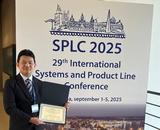Reduces Cooling Power of Superconducting Magnet by Half
Hitachi has developed 8-km-long magnesium diboride (MgB2) superconducting wire that can be used with refrigerator-based cooling without liquid helium, a scarce resource. Using this newly developed wire, Hitachi has manufactured a superconducting magnet for use in microwave generating equipment (klystrons) and has achieved a magnetic flux density of 0.8 tesla at a temperature of 20 K (-253℃) in tests. This technology enables the generation of intense magnetic fields with small currents, which can reduce the amount of thermal penetration into the interior of the superconducting magnet and reduce cooling power by half compared with existing superconducting magnets. By using this wire to achieve even stronger superconducting magnets, Hitachi plans to decrease power consumption in existing superconducting equipment such as magnetic resonance imaging (MRI)*1 devices. It also plans to contribute to environmental load reduction by expanding the application of this superconducting wire to the energy and transportation fields.

Fig. 1 Cross-section photo and external view of MgB2 superconducting wire (wire diameter: 0.67 mm)
Background and issues
- For superconducting magnets used in klystrons in accelerator facilities, must be applied to energy saving is a serious issue because approximately half of the power consumed by excitation of the magnet.
- To achieve energy saving in superconducting magnet, Hitachi took up the challenge of making performance uniform across 8 km of wire.
Developed technology
- MgB2 superconducting wire thinning technology causing no damage to the 30-µm-thick metallic layer protecting the MgB2 filaments.
Verified effect
On operating a superconducting magnet for klystron use at a temperature of 20 K using the MgB2 wire manufactured with this technology, it was verified that a superconducting state could be maintained for refrigerator power consumption under 3 kW, which is less than half that of existing superconducting magnet (NbTi*2).
Papers presented, academic societies, events, etc.
Hitachi presented a portion of these results at the 26th International Conference on Magnet Technology held from September 22, 2019 in Canada.
Details of developed technology
Although MgB2 can be obtained by heating a mixture of magnesium and boron powders, it is necessary to protect that powder mixture by covering it with an appropriate metal. Up to now, it has been difficult to achieve wire thinning while preserving this metallic protective layer, and as a result, wiring length has been kept at several hundred meters. The metallic protective layer of the developed wire is approximately 30-µm thick, but Hitachi has developed MgB2 superconducting wire thinning technology by clarifying the wire cross sectional configuration and processing conditions that would hinder the breaking down of this protective layer. Hitachi has achieved uniform MgB2 wire over a length of 8 km as a result. Wire lengthening in this way makes it possible to reduce the number of wiring connections in the manufacture of superconducting magnets and lower their cost.
Details of verified effect
The strength of the magnetic field created by a superconducting magnet is proportional to the product of the current flowing in the electromagnet and the number of turns of the superconducting wire wound in an electromagnet shape (i.e., the length of the superconducting wire). In superconducting magnets used for klystrons, Hitachi has generated intense magnetic fields even with small currents by configuring a superconducting magnet using approximately 6 km of the developed wire.*3 This configuration achieves a superconducting magnet that reduces the amount of heat penetrating the cooling section from the room-temperature section at the electrode*4 and that preserves the superconducting state with a refrigerator consuming less than 3 kW of power, which is less than half that of existing superconducting magnet (NbTi).

Fig. 2 Issues and solutions in reducing cooling power by half in MgB2 superconductor and superconducting magnet
*1 MRI is a technique for obtaining images of the interior of the body using magnetic resonance.
*2 Low temperature superconducting wire, Niobium-Titanium alloy.
*3 Magnetic flux density of 0.8 tesla is achieved in the center of the magnet for a flowing current of 57.1 amperes.
*4 This is the electrode used for driving current into the electromagnet from an external power supply. The electrode must be made thicker to accommodate an increase in the value of flowing current, but the amount of penetrating heat increases in proportion to a square of that thickness.
For more information, use the enquiry form below to contact the Research & Development Group, Hitachi, Ltd. Please make sure to include the title of the article.
https://www8.hitachi.co.jp/inquiry/hitachi-ltd/hqrd/news/en/form.jsp









